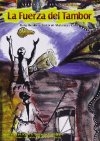Review by Miguel “Willie” Ramos, Ilarí Obá
Kabiosile Productions and Tina Gallagher have done it once again. The new ethnographic DVD, “La Fuerza del Tambor,” shot entirely on location in Matanzas, Cuba, is another captivating window into the world of Lukumí religion, and in this case Afro-Cuban drumming, in that other Cuban Mecca, Matanzas. For olorishas in the United States and elsewhere, unfamiliar with the variety and variations that exist in that city, this is a welcome addition to the Kabiosile legacy.
The DVD’s principal protagonist, Babalorisha and Olubatá Alfredo Calvo, Alá Aganjú, is one of Matanzas most respected and senior priests, descended from the renowned Egbadó priestess Ma Monserrate González, Obá Tero and her religious progeny, Fermina Gómez, Oshabí. Calvo’s insight and experience as a priest, a drummer and a living repository or Afro-Cuban culture in Matanzas is one of the highest peaks of this film. His ability to discuss numerous themes associated with Afro-Cuban religions, primarily Lukumí, Bantú and Abakuá, is remarkable and his interpretations are often ingenious and provocative.
Calvo’s abilities as a mentor and teacher are clearly exemplified by the other olorishas and drummers that participate in the interviews. They share Calvo’s insight, but also contribute their own understanding, their own visions of what Afro-Cuban culture represents, especially when viewed through the eyes of a member of the culture. For the foreigner, religious or not, this is an important insight into modern Cuba as it reflects African culture’s impressive ability to adapt to whatever circumstances it encounters and subsequently prevail.
One of the DVD’s high points is the description and demonstration of the Macagua Bembé drums, a specific drum ensemble that was given to the Lukumí priest Gerardo de Las Mercedes Valdez, better known as “Cheo Changó,” by the Arará Mahíno, a Dahomean sub-group, some time in the mid twentieth century. This gift may well mark the onset of collaboration between the Lukumí and Arará peoples in Matanzas that oral history tells us may have had a lingering rivalry in the nineteenth century. Though there are other bembé ensembles in Cuba, all of which consist of three peg-type drums, Macagua is unique among Cuba’s bembé drums because it has an additional drum, the reason for which I will not reveal here to maintain the element of surprise. Suffice it to say that this is another example of African ingenuity and adaptability.
Other high points in the film are the scenes from actual wemileres and bembés in Matanzas, which similar to Kabiosile’s first film, include actual possessions, possibly one of the first times that these are documented in Cuba. No doubt, these scenes alone will generate much conversation among the members of the religious communities outside of Cuba. But there are other surprises as well that will surely stimulate further conversation and discussion.
Though the film is highly educational and not meant to be controversial per se, it does raise important issues that must be considered in the light of the increasing internationalization of Lukumí religion and its encounters with other African religions and traditions in the Americas. This makes “La Fuerza del Tambor” one of the most important films to come out of Cuba in recent years. It is a must for the serious student of Lukumí culture and Afro-Cuban drumming. Modupé ó Tina Gallagher and Kabiosile Productions.





Sorry, the comment form is closed at this time.